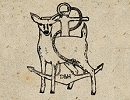Contact Seller
Doe And Hope
Tel07729 213013Please quote Antiques Atlas.


 19th Century Anatomical Wax Head on Framed Board
19th Century Anatomical Wax Head on Framed Board
 Adam Rouilly Medical Chart OG 17 Female Pelvis
Adam Rouilly Medical Chart OG 17 Female Pelvis
 Circa 1930s Anatomical Poster - Dislocation
Circa 1930s Anatomical Poster - Dislocation
 19th Century Anatomical Didactic Abdominal Model
19th Century Anatomical Didactic Abdominal Model
 Adam Rouilly model of an Eye
Adam Rouilly model of an Eye
 Collection 8 Medical Anatomical Models, c1960
Collection 8 Medical Anatomical Models, c1960
 Cased Adam Rouilly Anatomical Arm Model, c1960
Cased Adam Rouilly Anatomical Arm Model, c1960
 Collection Of 3 Medical School Teaching Aids,c1960
Collection Of 3 Medical School Teaching Aids,c1960
 1942 J.Teck St John's Ambulance General Anatomy Po
1942 J.Teck St John's Ambulance General Anatomy Po
 1940's St John's Ambulance Dislocations Poster
1940's St John's Ambulance Dislocations Poster
 Anatomical Elbow Joint Model by ESP Limited
Anatomical Elbow Joint Model by ESP Limited
 Collection Medical School Teaching Aid Bones,c1960
Collection Medical School Teaching Aid Bones,c1960
Non UK callers :
+44 7729 213013
Pair of Early 20thC Human Prosthetic Glass Eyes


In original condition and fantastically well made are these genuine human glass prosthetic eyes having superbly detailed hazel coloured iris’s, the wholes in shell like form.
In generally good order, the eyes have no chips or cracks, though one has some small surface wear to the coloured surface.
The introduction of cryolite glass by German craftsmen in 1835 produced a grayish-white color suitable for a prosthetic eye. To make these glass eyes, a tube of glass was heated on one end until the form of a ball was obtained and various colours of glass were then used like paintbrushes to imitate the natural colours of the eye. This glass art form flourished particularly in France and Germany where secrets of production were handed down from one generation to the next. In the 19th century, German craftsmen (or"ocularists") began to tour the world, setting up for several days at a time in one city where they fabricated eyes and fitted them to patients. By the mid-1940s, glass eyes were being replaced by plastic counterparts.
A collector’s item for those with an eye for the peculiar. Make that two eyes.
SellerDoe And Hope
View all stock from
Doe And Hope

 Private dealer, By appointment only
Private dealer, By appointment only
The Onion Barn, Shoe Cottage,
15 High Street, Blunham,
Bedfordshire, MK44 3NL.
MK44 3NL
Tel : 07729 213013
Non UK callers : +44 7729 213013
Get directions to Doe And Hope
In generally good order, the eyes have no chips or cracks, though one has some small surface wear to the coloured surface.
The introduction of cryolite glass by German craftsmen in 1835 produced a grayish-white color suitable for a prosthetic eye. To make these glass eyes, a tube of glass was heated on one end until the form of a ball was obtained and various colours of glass were then used like paintbrushes to imitate the natural colours of the eye. This glass art form flourished particularly in France and Germany where secrets of production were handed down from one generation to the next. In the 19th century, German craftsmen (or"ocularists") began to tour the world, setting up for several days at a time in one city where they fabricated eyes and fitted them to patients. By the mid-1940s, glass eyes were being replaced by plastic counterparts.
A collector’s item for those with an eye for the peculiar. Make that two eyes.
Price The price has been listed in British Pounds.
Conversion rates as of 2/JAN/2025. Euro & Dollar prices will vary and should only be used as a guide.
Always confirm final price with dealer. Phone or visit the website to buy, Free UK shipping.
DimensionsWidth 1.4 inches (each)
Category Medical Antiques
Date c.1910-30
Early 20th Century Antiques Material Glass
Origin British
Condition Good.
Item code as155a558
Status Sold
£99.00 
$122.51 
€119.25 

$

€

Conversion rates as of 2/JAN/2025. Euro & Dollar prices will vary and should only be used as a guide.
Always confirm final price with dealer. Phone or visit the website to buy, Free UK shipping.
View all stock from
Doe And Hope

 Private dealer, By appointment only
Private dealer, By appointment onlyThe Onion Barn, Shoe Cottage,
15 High Street, Blunham,
Bedfordshire, MK44 3NL.
MK44 3NL
Tel : 07729 213013
Non UK callers : +44 7729 213013
Get directions to Doe And Hope
You may also be interested in
 19th Century Anatomical Wax Head on Framed Board
19th Century Anatomical Wax Head on Framed Board
 Adam Rouilly Medical Chart OG 17 Female Pelvis
Adam Rouilly Medical Chart OG 17 Female Pelvis
 Circa 1930s Anatomical Poster - Dislocation
Circa 1930s Anatomical Poster - Dislocation
 19th Century Anatomical Didactic Abdominal Model
19th Century Anatomical Didactic Abdominal Model
 Adam Rouilly model of an Eye
Adam Rouilly model of an Eye
 Collection 8 Medical Anatomical Models, c1960
Collection 8 Medical Anatomical Models, c1960
 Cased Adam Rouilly Anatomical Arm Model, c1960
Cased Adam Rouilly Anatomical Arm Model, c1960
 Collection Of 3 Medical School Teaching Aids,c1960
Collection Of 3 Medical School Teaching Aids,c1960
 1942 J.Teck St John's Ambulance General Anatomy Po
1942 J.Teck St John's Ambulance General Anatomy Po
 1940's St John's Ambulance Dislocations Poster
1940's St John's Ambulance Dislocations Poster
 Anatomical Elbow Joint Model by ESP Limited
Anatomical Elbow Joint Model by ESP Limited
 Collection Medical School Teaching Aid Bones,c1960
Collection Medical School Teaching Aid Bones,c1960




